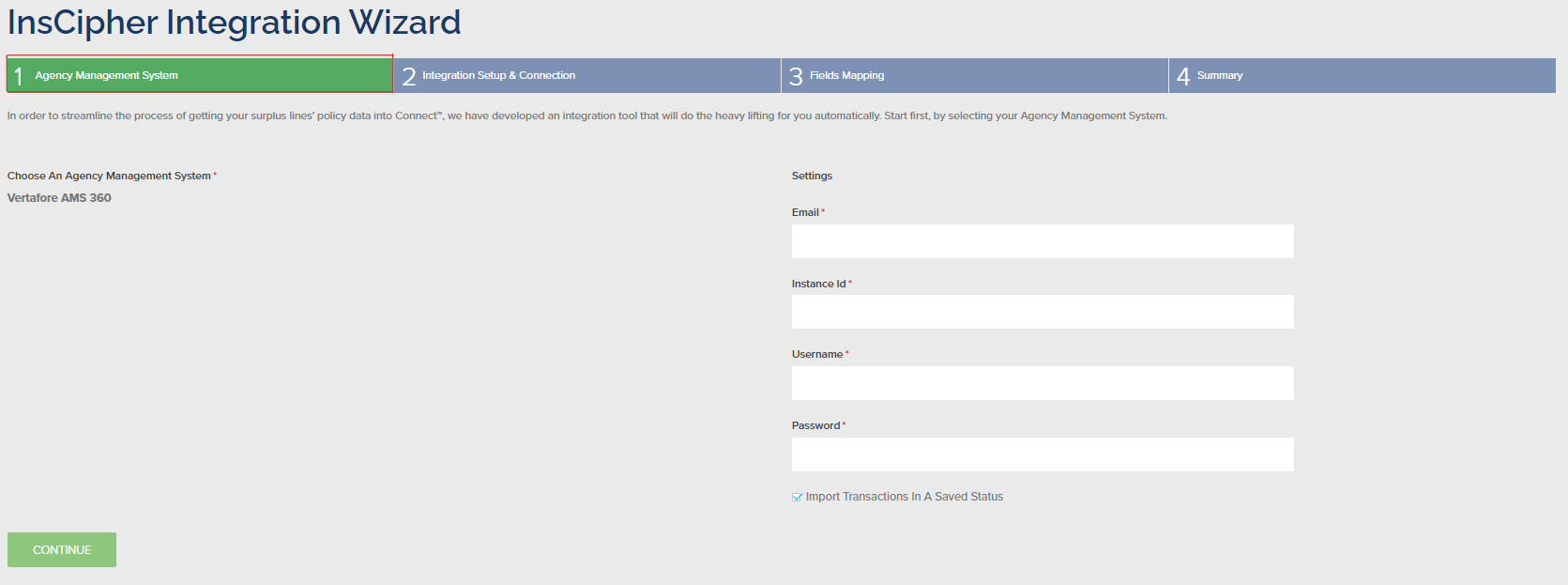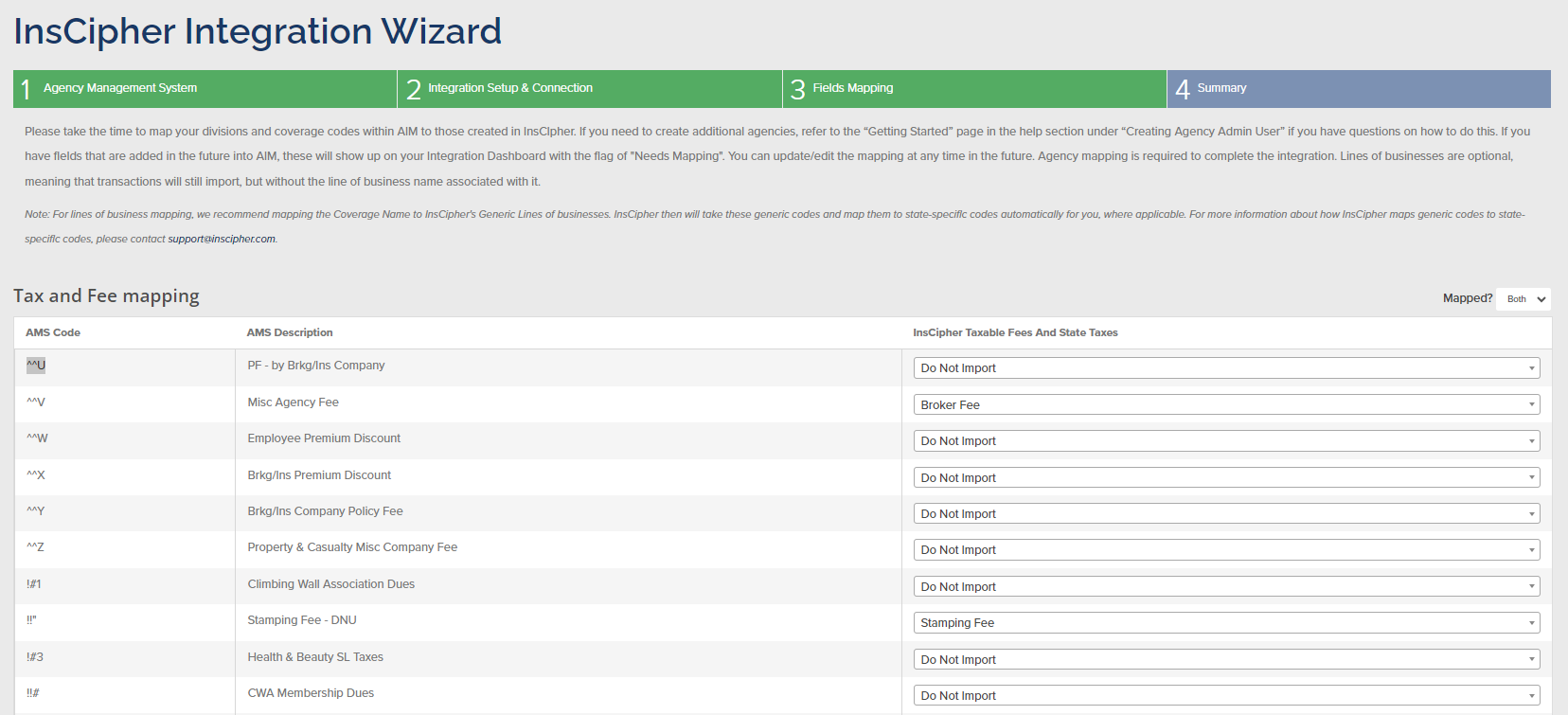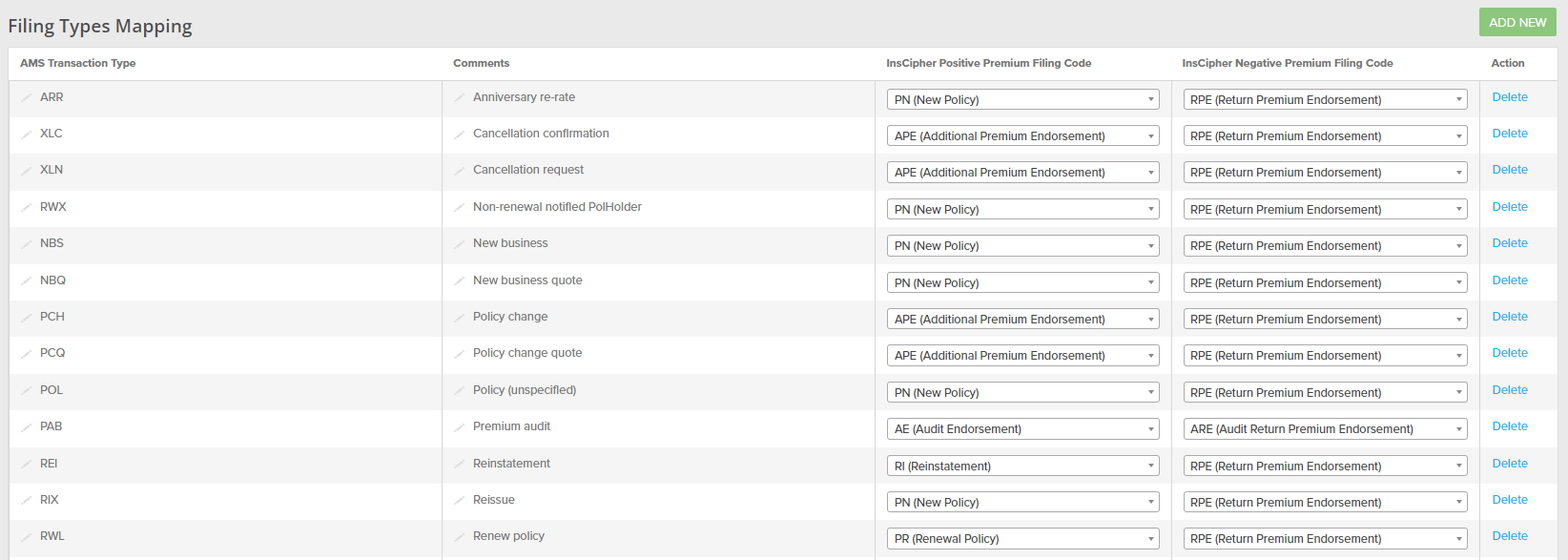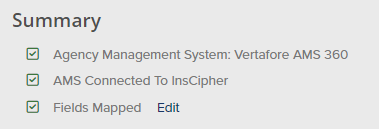Import Policy Data
Steps in completing the Integration
To fully connect your agency's AMS360 instance to InsCipher to start importing policy data, you will need to complete a series of 4 steps within the InsCipher Integration Tool.
Step 1: Setup & Connection
To begin, you will first need to log into your Connect® account. Click on the Settings cog in the top right navigation bar > “Integrations” > then click on the “ADD NEW” button to start the Integration Wizard. This wizard guides you through a 4-step process of installation. Select Vertafore AMS360 from the dropdown to add the integration.

Step 1 - Agency Management System settings
Step 1 involves the input of credentials mentioned in Technical Installation Details > Step 4, which are Email, Instance Id, Username and Password. All of these fields are required to move to Step 2.
Step 2: Initiate Mappings and install API connection

Step 2 - Integration Setup & Connection
In Step 2, the InsCipher connection to your instance of AMS360 is established and fields pulled for the mapping exercise in Step 3 - Fields Mapping, are verified. Unless there are errors with the API connection and/or in retrieving mapping data, there should be no need for manual input here and you can proceed to Step 3.
Step 3: Field Mapping
Once the connection is complete and the Integration Tool is synced with InsCipher Connect®, Step 3 involves the requirement to manually map the data pulled in from your instance of AMS360 by the integration tool to standard values within InsCipher to ensure data parity. The tables required to map in the Field Mapping step are:
- Taxes and Fees
- Line of Business (LOB)
- Business Units
- Filing Types
- Insurance Companies
You will need to map all of these values in order to proceed to Step 4.
Map Taxes and Fees
The first of the required sections to map involves the Tax and Fee Mapping table (ex. shown below):

Step 3 - Tax and Fee mapping table
Here, the integration pulls in both AMS Code and AMS Description for each of the AMS360 fields relating to taxes or fees. To begin the mapping process, choose one of the options per AMS Code line item to map these values to in the dropdown under InsCipher Taxable Fees and State Taxes. The mapping options are:
- Do Not Import
- Broker Fee
- Carrier Fee
- Stamping Fee
- Sl Tax
- EMPA Tax
- FM Tax
- Municipal Fee
- Sl Service Charge
Map Lines of Business (LOB)
Once you’ve mapped Taxes and Fees, move down to complete Line of Business Mapping table:

Step 3 - Line of Business Mapping table
Here you’ll be asked to map the derived AMS codes for individual Lines of Business (LOB) to an InsCipher Generic Line of Business code. You can do this using the State Specific to Generic LOB mapping worksheet or the more simplified Generic Lines of Business worksheet. If necessary, you can map specific LOB codes per AMS code under the InsCipher State Specific Codes column, where an option to select a state and LOB description are given.
More information on Line of Business in AMS360.
Map Business Units
Next you will need to complete the Business Unit Map section. This is where you will be able to enable or disable the import of policy data related to a specific business unit tag in AMS360.

Step 3 - Business Unit Map table
By default, the integration is able to pull in business unit information down to the Group level in AMS360. Under the Import column, you will choose whether to enable import or leave as is - the default state is Import Disabled.
More information on Business Units in AMS360.
Map Filing Types

Step 3 - Filing Types Mapping table
Filing or Transaction type naming and usage vary from AMS360 and InsCipher. In order to ensure these are mapped correctly, custom mapping is available within the Filing Types Mapping table with the option of having a transaction type vary for positive and negative amounts to match your specific workflow.
Here, the type of Policy Transaction Codes are pulled from AMS360 under the AMS Transaction Type column along with a corresponding Description, which are listed under the column labeled Comments. Within InsCipher, this will need to translate and map to platform-defined transaction types associated with negative or positive premium as defined by the platform using the InsCipher Positive Premium Filing Code and / or Negative Premium Filing Code dropdowns. Within those dropdowns, these are the InsCipher transaction types to map to:
- PN (New Policy)
- PR (Renewal Policy)
- APE (Additional Premium Endorsement)
- RPE (Return Premium Endorsement)
- AE (Audit Endorsement)
- FC (Flat Cancellation)
- ZPE (Zero Premium Endorsement)
- PC (Pro Rata Cancellation)
- XE (Extension Endorsement)
- RI (Reinstatement)
- BO (Back-out / Reversal)
- BD (Binder)
More information on Policy Transaction Codes in AMS360.
Map Insurance Companies

Step 3 - Insurance Company Mapping table
The final table to map on Step 3 is Insurance Company Mapping. Here, Insurance Company Code and Name are pulled from AMS360 and displayed in the first two columns. The manual mapping requirement is necessary in the third column, InsCipher Insurance Company, where for each insurance company code/name derived from the integration, the requirement is to map it with a corresponding Insurance Company on record with InsCipher.
Step 4: Summary
The final step of the integration tool is a review of the Steps completed and any issues that are still outstanding. Having the following items checked as complete indicates that there are no outstanding issues with the integration:

An integration connection made during the day may only populate with policy data the next day due to the cadence of the integration. Please reach out to InsCipher support if data in the Filings Import Log is not populated promptly within the next day.
You also have the option to pull in up to two weeks of historical data from AMS360 using the Trigger a Manual Import button.

In choosing a date, you will be limited by the Import From calendar picker component to two weeks prior to the current date. Once this request is submitted, it can take up to 30 minutes for this data to appear in the Filings Import Log.
If there are errors or other issues with the status of the integration, you will see them on this page.
Updated 2 months ago